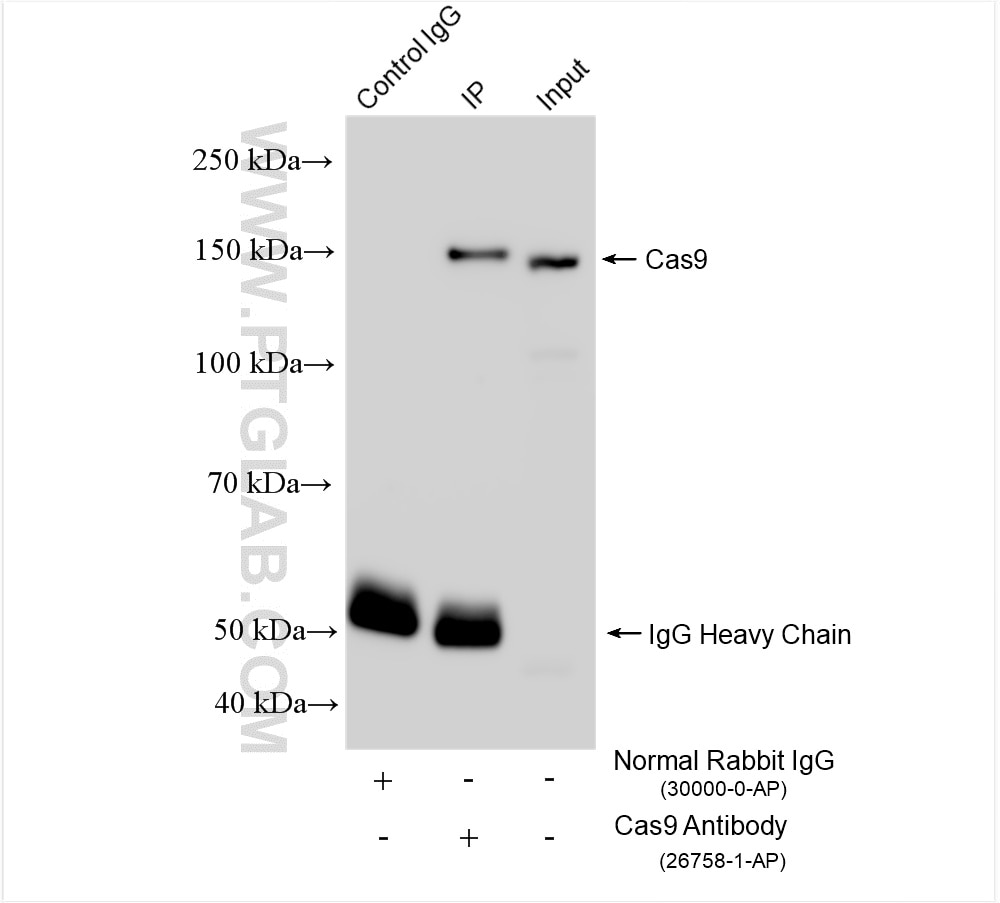Validation Data Gallery
Tested Applications
| Positive WB detected in | HeLa cells, A431 cells |
| Positive IP detected in | HeLa cells |
Recommended dilution
| Application | Dilution |
|---|---|
| Western Blot (WB) | WB : 1:1000-1:8000 |
| Immunoprecipitation (IP) | IP : 0.5-4.0 ug for 1.0-3.0 mg of total protein lysate |
| It is recommended that this reagent should be titrated in each testing system to obtain optimal results. | |
| Sample-dependent, Check data in validation data gallery. | |
Published Applications
| WB | See 3 publications below |
Product Information
26758-1-AP targets Cas9 in WB, IP, ELISA applications and shows reactivity with bacteria samples.
| Tested Reactivity | bacteria |
| Cited Reactivity | human |
| Host / Isotype | Rabbit / IgG |
| Class | Polyclonal |
| Type | Antibody |
| Immunogen |
CatNo: Ag25281 Product name: Recombinant Cas9 protein Source: e coli.-derived, PET30a Tag: 6*His Domain: 1-100 aa of NP_269215 Sequence: MDKKYSIGLDIGTNSVGWAVITDEYKVPSKKFKVLGNTDRHSIKKNLIGALLFDSGETAEATRLKRTARRRYTRRKNRICYLQEIFSNEMAKVDDSFFHR 相同性解析による交差性が予測される生物種 |
| Full Name | Cas9 |
| Calculated molecular weight | 160 kDa |
| GenBank accession number | NP_269215 |
| Gene Symbol | |
| Gene ID (NCBI) | |
| RRID | AB_2918109 |
| Conjugate | Unconjugated |
| Form | |
| Form | Liquid |
| Purification Method | Antigen affinity purification |
| UNIPROT ID | Q99ZW2 |
| Storage Buffer | PBS with 0.02% sodium azide and 50% glycerol{{ptg:BufferTemp}}7.3 |
| Storage Conditions | Store at -20°C. Stable for one year after shipment. Aliquoting is unnecessary for -20oC storage. |
Background Information
Cas9 (CRISPR associated protein 9) is an RNA-guided DNA endonuclease enzyme associated with the CRISPR (Clustered Regularly Interspaced Short Palindromic Repeats) adaptive immunity system in Streptococcus pyogenes. This antibody detects the sp Cas9.
This antibody can recognize Cas9 protein with point mutations, such as dCas9 and nCas9.
Protocols
| Product Specific Protocols | |
|---|---|
| IP protocol for Cas9 antibody 26758-1-AP | Download protocol |
| WB protocol for Cas9 antibody 26758-1-AP | Download protocol |
| Standard Protocols | |
|---|---|
| Click here to view our Standard Protocols |
Publications
| Species | Application | Title |
|---|---|---|
Adv Sci (Weinh) Enhancing Prime Editing Efficiency Through Modulation of Methylation on the Newly Synthesized DNA Strand and Prolonged Expression | ||
Clin Epigenetics E2F1 combined with LINC01004 super-enhancer to promote hepatocellular carcinoma cell proliferation and metastasis |



